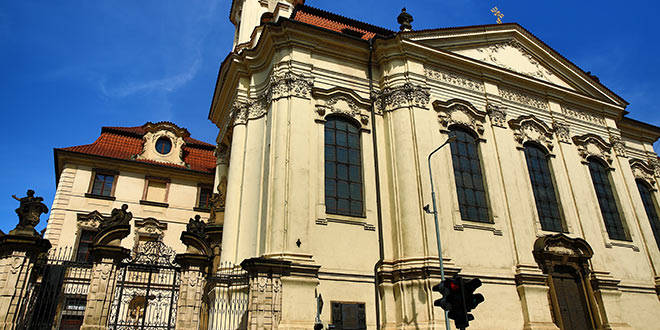This Baroque church was first consecrated to St. Charles Borromeus and built together with a house for emeritus priests in 1730-1739. The church and the house were abolished in 1783 and used for several purposes. It took nearly 150 years before the church was given to the Orthodox Church and consecrated to Sts Cyril and Methodius.
The church is situated on a raised terrace after the ground shaping of the neighbourhood. Baroque frescoes inside the church are edged with stuccoes. The garden in front of the church is framed with a Baroque fence decorated with statues of angels.
The church became very well-known during WWII. Seven Czech paratroopers died here on 18 June 1942, after taking part in the assassination of the Nazi Governor of Bohemia and Moravia, Reinhard Heydrich. Members of the Czech Orthodox community helped them hid in the crypt, but they were betrayed and attacked in the church by the Gestapo and committed suicide rather than fall into enemy hands.
On the wall of the crypt near a window, where you can still see the holes from the bullets, is the memorial plaque with the names and portraits of the heroes. The crypt serves now as a National Memorial to the victims of the Heydrich Terror. Crypt can be visited by appointment only.
Location: Resslova 9, New Town
Open: Apr—Oct Tue—Sun 10-5; Nov—Mar Tue—Sun 10-4.
www.pravoslavnacirkev.cz
Other names: Church of St Cyril and Methodius; Kostel sv. Cyrila a Metoděje




I think you can view the film “Operation Daybreak” (1976) online. Just Google the title and you will be guided to it on You Tube.
There is also a book, “The Killing of Reinhard Heydrich” (1989) by Callum MacDonald. It is now published by Da Capo Press, (1998) and should be available in your public library. It is a re-issue of the original book that had a longer title. It’s all on Google.
The Orthodox Church of Sts. Cyril and Methodius is on Resslova Street, just up a block or two from the Dancing Building, (Fred and Ginger) and near to Charles Square. As part of its history, the church has a connection to the Serbian Orthodox community in Prague but I am not clear on exactly what that was or is.
In the crypt below the church is the memorial to the seven brave Czech soldiers who assassinated Reinhard Haydrich in Prague in 1942, sought refuge in the church afterwards, were betrayed and gave up their lives when discovered and attacked by the nazis. The memorial is a National Monument and is open to the public and can be visited most days during daylight hours. No appointment is necessary and a small donation is requested upon entering. On the Resslova street side of the church you can still see the pockmarks where the nazi’s bullets hit the walls while the parachutists were under siege. There is also an opening into the crypt on this same wall where the nazis poured in water trying to flush the surviving men out. The opening is a modest memorial to the men whose bronze busts are in the actual crypt. Whenever I visit Prague, I, along with others, place a few flowers at the opening as a gesture of respect to these brave and patriotic soldiers. If you like to look at history from the ‘bottom up’ this memorial and the events it commemorates will touch you in a way not many can and connect you these brave men on a personal level. It is one thing to know the historical facts. It is quite another to viscerally connect with the brave but tragic lives of the people behind them.
2 years ago my Husband and I spent a lovely short holiday in Prague, which we thought to be the most beautiful City we had thus visited. We also visited St Cyril and Methodius church where the brave parachutists and local partizans died during WW11, this was a most moving experience and I have since obtained a DVD of Operation Daybreak which told this heroic story. It was filmed in the exact places in Prague that all these terrible things happened. I would like to think that I shall return to Prague at some future date to experience again the loveliness of Prague.